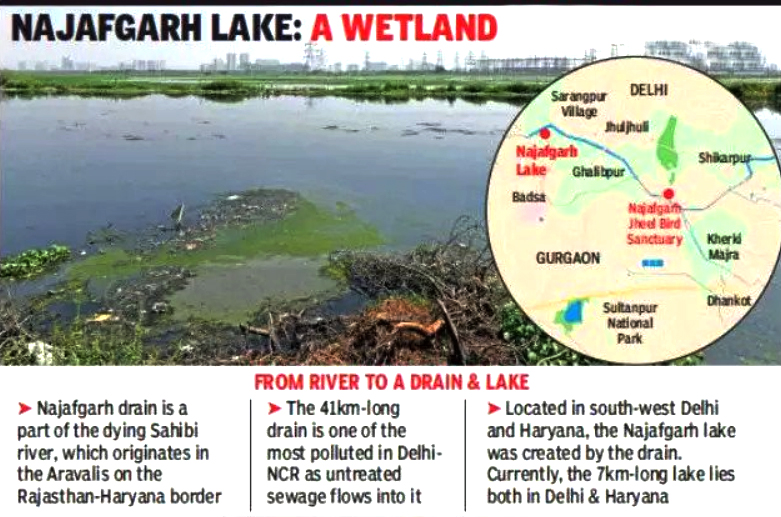Environment Management Plan for Najafgarh Jheel | 25 Jan 2022
For Prelims: National Green Tribunal, Environment Management Plan, Najafgarh jheel, National Wetland Authority, Sarus Crane and other Birds, Central Asian Flyway, Microclimate
For Mains: Environmental Pollution & Degradation, Njafgarh Jheel and its significance, National Green Tribunal.
Why in News
Recently, the National Green Tribunal (NGT) has directed Delhi and Haryana to enforce the Environment Management Plan (EMP) that the two governments have prepared for the rejuvenation and protection of the Najafgarh Jheel, a transboundary wetland.
- The implementation of these action plans is to be monitored by the National Wetland Authority through the respective State Wetland Authorities.
- Earlier, the Union Environment Ministry had set up a three-member committee to prepare an integrated EMP.
Key Points
- The Environment Management Plan:
- The top priority would be to notify the Najafgarh jheel and its area of influence under The Wetlands (Conservation and Management) Rules, 2017.
- The rules prohibit and regulate certain activities within wetlands and their ‘zone of influence’.
- It lists immediate measures to be taken including demarcating the boundary of the wetland using geo-tagged pillars, and commissioning a hydrological assessment and species inventory.
- Medium-term measures to be implemented in two to three years include in-situ treatment of major drains meeting the Najafgarh jheel, regular monitoring of the waterbird population, and relocating flow obstructions such as power sub-stations.
- The jheel is known to be a habitat for migratory and resident waterbirds.
- It also proposes a detailed estimation of sewage generation in the area considering 15 years of projected population, and identification of all drains contributing to pollution in the jheel.
- The top priority would be to notify the Najafgarh jheel and its area of influence under The Wetlands (Conservation and Management) Rules, 2017.
- Najafgarh Jheel:
- It is located in a natural depression in southwest Delhi, close to the Gurugram-Rajokri border on National Highway-48.
- The lake is largely filled with sewage from Gurugram and surrounding villages of Delhi. A portion of the lake falls in Haryana.
- The presence of 281 bird species, including several threatened ones such as Egyptian vulture, Sarus Crane, Steppe Eagle, Greater Spotted Eagle, Imperial Eagle and those migrating along the Central Asian Flyway has been reported at the lake.
- Related Concerns:
- Once spread over 226 sq km, the water body straddling Delhi and Gurugram has shrinked to just seven sq km due to rampant encroachment.
- According to Indian National Trust for Art and Cultural Heritage (INTACH), the revival of the jheel would yield around 20 million gallons of water a day to support a population of 3.5 lakh.
- INTACH is a non-profit charitable organisation registered under the Societies Registration Act, 1860.
- Despite being the source of several benefits and sustaining habitats of diverse species, Najafgarh Jheel has been highly fragmented and transformed, built upon, used as a waste receptacle, and infested with invasive species.
- The Sahibi river, of which Najafgarh Jheel was the natural floodplain, has been converted virtually into a drain. The decimation of wetlands has exposed the neighbouring settlements in Haryana and Delhi to high risks of pluvial flooding and reduced groundwater levels.
- Recent constructions within the wetlands, while impeding natural wetland functions, are precarious owing to high seismicity and liquefaction within the region.
- Once spread over 226 sq km, the water body straddling Delhi and Gurugram has shrinked to just seven sq km due to rampant encroachment.
- Significance:
- The Najafgarh Jheel is a critical natural infrastructure for the region, buffering floods, treating wastewater, recharging groundwater (with high potential for water supply to significant population) and providing habitat to numerous plant, animal and bird species.
- It can regulate the microclimate by virtue of being a heat and carbon sink. In fact, if the EMPs are properly and fully implemented, the jheel can become central to the National Capital Region’s ability to mitigate the local effects of climate change.
National Green Tribunal
- It is a specialised body set up under the National Green Tribunal Act (2010) for effective and expeditious disposal of cases relating to environmental protection and conservation of forests and other natural resources.
- With the establishment of the NGT, India became the third country in the world to set up a specialised environmental tribunal, only after Australia and New Zealand, and the first developing country to do so.
- The NGT Act provided a specialised role to the tribunal to act on issues where a dispute arose under seven specified laws (mentioned in Schedule I of the Act): The Water Act, The Water Cess Act, The Forest Conservation Act, Air Act, Environment Protection Act, Public Liability Insurance Act and the Biological Diversity Act.
- The NGT has five places of sittings, New Delhi is the Principal place of sitting and Bhopal, Pune, Kolkata and Chennai are the other four.
Wetlands
- Wetlands are areas where water is the primary factor controlling the environment and the associated plant and animal life. They occur where the water table is at or near the surface of the land, or where the land is covered by water.
- Wetlands are defined as: "lands transitional between terrestrial and aquatic eco-systems where the water table is usually at or near the surface or the land is covered by shallow water".
- 2nd February is World Wetlands Day. It was on this date in 1971 that the Ramsar Convention on Wetlands was adopted in Ramsar, Iran.

